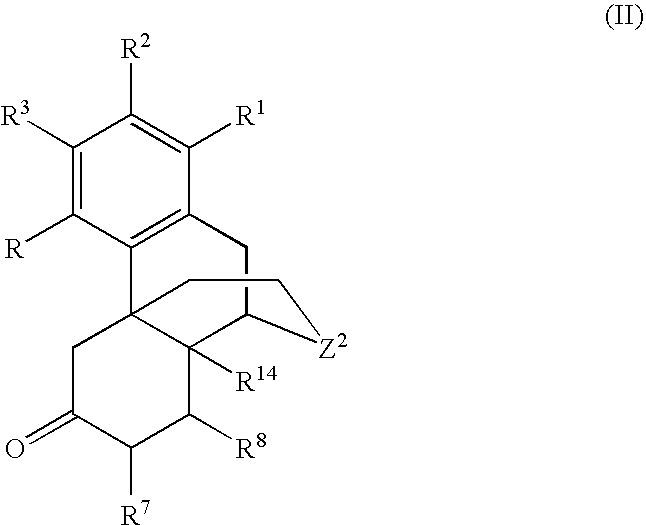Processes for the selective amination of ketomorphinans
- Summary
- Abstract
- Description
- Claims
- Application Information
AI Technical Summary
Benefits of technology
Problems solved by technology
Method used
Image
Examples
example 1
Synthesis of Nalbuphone from Noroxymorphone
[0103]Noroxymorphone (3.30 g, 11.5 mmol) was combined with 30 mL methanol (MeOH). Approximately 1.93 g (23 mmol) of cyclobutanecarboxaldehyde (CBCA) was added to the mixture and the slurry was stirred for about 3 hours at room temperature. At that time, a 5 to 2 mixture of 98% formic acid / triethylamine, prepared by adding 98% formic acid (5.34 g, 116 mmol) to triethylamine (4.70 g, 46.4 mmol) in 10 mL of methanol, was added to the slurry. In addition, 9.5 mg of di-p-chlorobis(ruthenium) (II) dimer was added to the slurry. The reaction was purged by nitrogen gas for 30 minutes and became homogeneous after this time. A steady flow of nitrogen was allowed to pass over the reaction. The reaction was stirred for 24 hours at room temperature. Evaporation of the mixture produced a thick oil, Approximately 10 mL of methanol was added and stirred at room temperature for 1 hour, and a precipitate formed. The precipitate was removed by filtration and ...
example 2
Synthesis of Nalbuphone from Noroxymorphone with Na2EDTA
[0104]Noroxymorphone (3.30 g, 11.5 mmol) was combined with 30 mL methanol (MeOH). Approximately 1.93 g (23 mmol) of cyclobutanecarboxaldehyde (CBCA) was added to the mixture and the slurry was stirred for about 3 hours at room temperature. At that time, a 5 to 2 mixture of 98% formic acid / triethylamine, prepared by adding 98% formic acid (5.34 g, 116 mmol) to triethylamine (4.70 g, 46.4 mmol) in 10 mL of methanol, was added to the slurry. In addition, 9.5 mg of di-p-chlorobis(ruthenium) (II) dimer followed by 3.76 g of disodium ethylene diamine tetraacetate (Na2EDTA) was added to the slurry. The reaction was purged by nitrogen gas for 30 minutes and became homogeneous after this time. A steady flow of nitrogen was allowed to pass over the reaction. The reaction was stirred for 24 hours at room temperature. Evaporation of the mixture produced a thick oil. Approximately 10 mL of methanol was added and stirred at room temperature ...
example 3
Synthesis of Nalbuphone from Noroxymorphone
[0105]Noroxymorphone (3.30 g, 11.5 mmol) was combined with 30 mL methanol (MeOH). Approximately 1.93 g (23 mmol) of cyclobutanecarboxaldehyde (CBCA) was added to the mixture and the slurry was stirred for about 3 hours at room temperature. At that time, a 5 to 2 mixture of 98% formic acid / triethylamine, prepared by adding 98% formic acid (5.34 g, 116 mmol) to triethylamine (4.70 g, 46.4 mmol) in 10 mL of methanol, was added to the slurry. In addition, 9.5 mg of di-p-chlorobis(ruthenium) (II) dimer was added to the slurry. The reaction was purged by nitrogen gas for 30 minutes and became homogeneous after this time. A steady flow of nitrogen was allowed to pass over the reaction. The reaction was stirred for 24 hours at room temperature. Evaporation of the mixture produced a thick oil. Approximately 10 mL of methanol was added and stirred at room temperature for 1 hour, and a precipitate formed. The precipitate was removed by filtration and ...
PUM
| Property | Measurement | Unit |
|---|---|---|
| temperature | aaaaa | aaaaa |
| temperature | aaaaa | aaaaa |
| temperatures | aaaaa | aaaaa |
Abstract
Description
Claims
Application Information
 Login to View More
Login to View More - R&D
- Intellectual Property
- Life Sciences
- Materials
- Tech Scout
- Unparalleled Data Quality
- Higher Quality Content
- 60% Fewer Hallucinations
Browse by: Latest US Patents, China's latest patents, Technical Efficacy Thesaurus, Application Domain, Technology Topic, Popular Technical Reports.
© 2025 PatSnap. All rights reserved.Legal|Privacy policy|Modern Slavery Act Transparency Statement|Sitemap|About US| Contact US: help@patsnap.com



